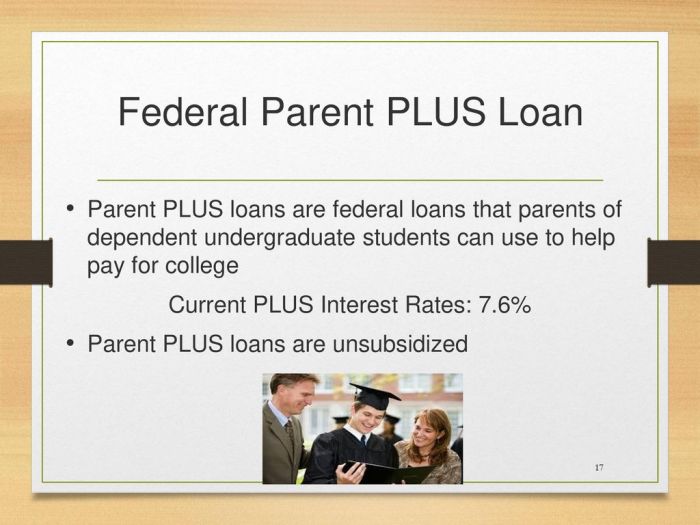
Navigating the complexities of student loan repayment can feel like traversing a maze. For parents who took out Parent PLUS loans to fund their child’s education, the question of refinancing often arises. This exploration delves into the possibility of transferring a Parent PLUS loan to the student, examining the eligibility requirements, available lenders, and the potential impact on federal loan benefits. Understanding the intricacies of this process is crucial for making informed financial decisions that can significantly affect long-term financial well-being.
This guide provides a comprehensive overview of the process, comparing private refinancing options with the advantages and disadvantages of retaining the federal loan. We’ll analyze the factors to consider before making a decision, including credit scores, income, and debt-to-income ratios. By weighing the potential risks and rewards, parents and students can determine the best course of action for their unique financial situations.
Parent PLUS Loan Refinancing Eligibility
Refinancing a Parent PLUS loan can offer significant savings on interest payments, but eligibility hinges on several key factors. Understanding these requirements is crucial before pursuing this option. Lenders assess applicants based on creditworthiness, income stability, and overall financial health. The process differs slightly from refinancing federal student loans, necessitating a careful review of each lender’s specific criteria.
Credit Score Requirements
A strong credit score is a cornerstone of Parent PLUS loan refinancing eligibility. Lenders typically require a minimum credit score, often ranging from 660 to 700 or higher, though this can vary significantly depending on the lender and the loan terms sought. A higher credit score generally translates to more favorable interest rates and loan terms. Individuals with lower credit scores might find it more challenging to qualify or may receive less attractive offers. Improving one’s credit score before applying can significantly increase the chances of approval and securing better rates.
Income and Debt-to-Income Ratio
Lenders evaluate an applicant’s income to ensure their ability to repay the refinanced loan. A stable income history is essential. In addition to income, the debt-to-income (DTI) ratio plays a vital role. The DTI ratio represents the percentage of your monthly income allocated to debt payments. A lower DTI ratio indicates a greater capacity to manage additional debt, increasing the likelihood of loan approval. Lenders generally prefer applicants with a DTI ratio below a certain threshold, typically around 43%, although this can vary. Applicants with high DTI ratios might need to explore strategies to lower their debt before applying.
Comparison with Federal Student Loan Refinancing
Refinancing a Parent PLUS loan differs from refinancing federal student loans. Federal student loan refinancing programs, often offered by the government or government-backed lenders, may have more lenient eligibility criteria, potentially accepting applicants with lower credit scores or higher DTI ratios. However, they may offer less flexibility in terms of interest rates and loan repayment options. Private lenders offering Parent PLUS loan refinancing generally have stricter eligibility requirements to mitigate risk.
Impact of Co-signers
A co-signer can significantly improve the chances of securing a Parent PLUS loan refinance. A co-signer with a strong credit history and stable income can offset a borrower’s weaker financial profile, making the loan application more appealing to lenders. However, it’s crucial to understand that adding a co-signer entails shared responsibility for repayment. Both the borrower and the co-signer are legally obligated to repay the loan if the borrower defaults. Careful consideration of this shared responsibility is essential before involving a co-signer.
Eligibility Requirements Across Different Lenders
The following table compares the eligibility requirements for Parent PLUS loan refinancing across several hypothetical lenders. Note that these are examples and actual requirements may vary. It is crucial to check directly with each lender for the most up-to-date and accurate information.
| Lender | Minimum Credit Score | Debt-to-Income Ratio Requirement | Co-signer Requirement |
|---|---|---|---|
| Lender A | 700 | 43% | Optional |
| Lender B | 680 | 40% | Recommended |
| Lender C | 720 | 35% | May be required |
| Lender D | 660 | 45% | Usually required |
Refinancing Options and Lenders

Refinancing your Parent PLUS loan can potentially lower your monthly payments and save you money on interest over the life of the loan. However, it’s crucial to carefully compare offers from different lenders to find the best option for your financial situation. Understanding the various refinancing options and lenders available is key to making an informed decision.
Several private lenders offer Parent PLUS loan refinancing options. These lenders typically assess your creditworthiness and offer terms based on your individual financial profile. The process involves applying with the lender, providing necessary documentation, and undergoing a credit check. Once approved, the lender will pay off your existing Parent PLUS loan and you’ll begin making payments to them under the new terms.
Lenders Offering Parent PLUS Loan Refinancing
A number of private lenders compete in the Parent PLUS loan refinancing market. Some well-known examples include Earnest, SoFi, and LendKey. It’s important to note that the availability of lenders and their specific offerings can change, so it’s always recommended to check directly with the lender for the most up-to-date information.
Interest Rates, Fees, and Repayment Terms
Interest rates, fees, and repayment terms vary significantly among lenders. Interest rates are usually based on your credit score, income, and the loan amount. Lower credit scores generally result in higher interest rates. Fees can include origination fees, late payment fees, and potentially prepayment penalties. Repayment terms, typically ranging from 5 to 15 years, impact your monthly payment amount; longer terms mean lower monthly payments but higher total interest paid. It’s essential to carefully compare these factors across different lenders to identify the most favorable terms.
Private Lender Refinancing vs. Federal Loan
Refinancing your Parent PLUS loan with a private lender offers the potential for lower interest rates and potentially more flexible repayment options compared to the federal loan. However, refinancing with a private lender means losing the federal loan protections, such as income-driven repayment plans and loan forgiveness programs. Keeping the federal loan guarantees access to these benefits, even if the interest rate is higher. The decision hinges on weighing the potential savings against the loss of federal protections. Consider your risk tolerance and long-term financial goals when making this choice.
Comparison of Parent PLUS Loan Refinancing Lenders
The following table provides a comparison of key features from three hypothetical lenders. Note that these are examples and actual rates, terms, and fees can vary and should be verified directly with each lender. Always review the lender’s terms and conditions before making a decision.
| Lender | Interest Rate Range | Repayment Term Options | Fees |
|---|---|---|---|
| Lender A | 6.00% – 12.00% | 5-15 years | 1% origination fee |
| Lender B | 5.50% – 11.50% | 7-12 years | 0% origination fee |
| Lender C | 6.50% – 13.00% | 5-10 years | 0.5% origination fee, $50 late payment fee |
Impact on Federal Loan Benefits
Refinancing your Parent PLUS loan to a private loan means trading the protections and benefits of a federal loan for potentially lower interest rates. This decision requires careful consideration, as the loss of federal benefits can have significant long-term financial implications. Understanding these implications is crucial before making a final decision.
Refinancing a Parent PLUS loan removes it from the federal student loan system. This transition eliminates access to several key federal benefits designed to make repayment more manageable. The potential loss of these benefits should be weighed against the potential savings from a lower interest rate.
Loss of Income-Driven Repayment Plans
Income-driven repayment (IDR) plans, such as ICR, PAYE, REPAYE, and IBR, are designed to tie your monthly payment amount to your income and family size. These plans are particularly beneficial for borrowers facing financial hardship. After refinancing, these options are no longer available. For example, a borrower struggling with a job loss might find themselves unable to manage their payments under a private loan, potentially leading to delinquency and damage to their credit score. The stability and flexibility provided by IDR plans are lost when refinancing.
Loss of Deferment and Forbearance Options
Federal student loans offer deferment and forbearance options, allowing borrowers to temporarily suspend or reduce their payments during times of financial difficulty, such as unemployment or serious medical issues. These options provide a safety net, preventing default and protecting credit scores. Private lenders typically offer less flexible options, if any at all. A parent who experiences an unexpected financial setback after refinancing might find themselves unable to pause their payments, potentially leading to serious financial strain.
Long-Term Financial Implications
The long-term financial implications of losing federal loan benefits can be substantial. Without access to IDR plans, borrowers might face higher monthly payments, potentially impacting their ability to save for retirement, purchase a home, or meet other financial goals. The lack of deferment or forbearance options can lead to delinquency and default, resulting in damaged credit scores, wage garnishment, and potentially even legal action. The long-term consequences of default can be severe and significantly impact a borrower’s financial well-being for years to come.
Potential Risks and Rewards of Refinancing
It’s important to weigh the potential benefits against the risks before deciding to refinance.
- Potential Rewards: Lower monthly payments due to a lower interest rate; a fixed interest rate avoiding potential increases in the future.
- Potential Risks: Loss of access to income-driven repayment plans; loss of deferment and forbearance options; inability to consolidate multiple loans; potential for higher overall interest paid if the loan term is shortened; damage to credit score if payments are missed.
The Refinancing Process
Refinancing a Parent PLUS loan can seem daunting, but understanding the steps involved simplifies the process. It involves comparing offers from different lenders, gathering necessary documentation, and completing the application. Careful planning and preparation can lead to securing favorable terms.
The refinancing process generally follows a sequential path, from initial application to loan disbursement. Each step requires attention to detail and careful consideration of the implications. The timeline can vary depending on the lender and the complexity of your application.
Step-by-Step Refinancing Process
The refinancing process typically involves these key steps: First, you’ll compare lenders and their offerings. Then, you’ll pre-qualify to get a sense of your eligibility. Next, you’ll formally apply, providing necessary documentation. The lender will then review your application, and finally, once approved, the funds will be disbursed.
Required Documents
Preparing the necessary documents beforehand streamlines the application process. A complete application minimizes delays and increases the chances of approval. Lenders typically require documentation verifying your identity, income, and the Parent PLUS loan details.
Commonly requested documents include:
- Government-issued photo ID
- Social Security number
- Proof of income (tax returns, pay stubs, W-2s)
- Parent PLUS loan details (loan number, servicer, outstanding balance)
- Credit report
Securing the Best Interest Rate and Terms
Several factors influence the interest rate and terms you receive. A strong credit score is crucial, and a higher credit score often translates to a lower interest rate. Shopping around and comparing offers from multiple lenders is essential to finding the most competitive rates. Furthermore, the loan amount and repayment term also play a role.
Tips for securing favorable terms include:
- Improve your credit score before applying.
- Compare offers from multiple lenders.
- Consider a shorter repayment term to potentially lower the overall interest paid, although this will result in higher monthly payments.
- Negotiate with lenders if possible.
Refinancing Process Flowchart
The following describes a visual representation of the refinancing process. Imagine a flowchart starting with a box labeled “Begin”. An arrow leads to a box labeled “Compare Lenders & Offers”. Another arrow leads from this box to “Pre-qualify”. This is followed by “Apply & Submit Documents”. An arrow leads to “Lender Review & Approval”. A “yes” branch from this box leads to “Loan Disbursement” and an “end” box. A “no” branch leads to “Application Denied/Resubmission”. This loop back to the “Apply & Submit Documents” box allowing for iterative improvements to the application.
Considerations Before Refinancing

Refinancing a Parent PLUS loan can significantly impact your long-term financial health. It’s crucial to approach this decision with careful consideration of various factors, ensuring it aligns with your overall financial goals and doesn’t inadvertently create more financial burden. A thorough assessment of your current financial situation and future projections is paramount before proceeding.
Understanding the implications of refinancing requires analyzing your current interest rate against prevailing market rates, projecting your future income, and evaluating how refinancing fits within your broader financial objectives. Failure to do so could lead to unforeseen consequences, potentially worsening your financial situation instead of improving it.
Current Interest Rates and Market Trends
Current interest rates play a pivotal role in determining the viability of refinancing. If market interest rates are significantly lower than your current Parent PLUS loan interest rate, refinancing could result in substantial savings over the life of the loan. Conversely, if rates are higher or only marginally lower, refinancing might not be financially beneficial, potentially increasing your overall interest payments. For instance, if your current PLUS loan carries a 7% interest rate and market rates offer a 4% refinance option, refinancing is likely advantageous. However, if market rates are 7.5%, refinancing would be detrimental. Staying informed about prevailing interest rate trends through reputable financial sources is essential.
Future Income Projections and Debt Management
Your future income projections are crucial for assessing your ability to manage the new loan payments. Refinancing might involve a longer repayment term, leading to lower monthly payments but higher overall interest paid. Conversely, a shorter repayment term could result in higher monthly payments but lower total interest. Consider your anticipated income growth and whether you can comfortably afford the new monthly payments without jeopardizing other financial commitments. For example, a recent graduate with a projected substantial income increase might find refinancing beneficial, allowing them to consolidate debt and potentially lower their monthly payments. Conversely, someone facing job insecurity or a period of reduced income might find a longer repayment term less risky, even if the overall interest paid is higher.
Long-Term Financial Goals and Refinancing Impact
Refinancing should align with your broader financial goals. If you prioritize paying off debt quickly, a shorter repayment term might be preferable, despite higher monthly payments. If minimizing monthly expenses is your priority, a longer term might be more suitable, despite paying more interest over the life of the loan. Consider factors like saving for a down payment on a house, investing for retirement, or paying off other high-interest debts. A well-defined financial plan helps determine if refinancing is a suitable strategy to achieve those goals. For example, if saving for a down payment is a priority, it might be wiser to maintain current payments and accelerate savings rather than refinance and potentially extend the repayment timeline.
Beneficial Refinancing Scenario
Imagine a family with a $50,000 Parent PLUS loan at 7% interest. They find a refinance option at 4% interest with a similar repayment term. The lower interest rate would significantly reduce their total interest paid over the loan’s lifetime, resulting in substantial savings. This scenario demonstrates a clear financial benefit from refinancing.
Detrimental Refinancing Scenario
Consider a family with the same $50,000 Parent PLUS loan at 7%, but they only find refinance options at 8% interest. Refinancing in this scenario would increase their overall interest paid and monthly payments, making it a financially unwise decision. This highlights the importance of comparing rates thoroughly before committing to refinancing.
Ending Remarks

Refinancing a Parent PLUS loan to a student presents a complex financial decision requiring careful consideration. While the potential for lower interest rates and simplified repayment is alluring, it’s crucial to thoroughly weigh the implications of losing valuable federal loan benefits. By understanding the eligibility requirements, comparing lender options, and carefully assessing your personal financial circumstances, you can make an informed choice that aligns with your long-term financial goals. Remember to explore all available resources and seek professional financial advice before proceeding.
FAQ Compilation
Can I refinance a Parent PLUS loan even with a low credit score?
While a higher credit score improves your chances of approval and securing favorable interest rates, some lenders may offer refinancing options for borrowers with lower scores. However, you might encounter higher interest rates or stricter requirements.
What happens if I default on a refinanced Parent PLUS loan?
Defaulting on a private refinanced loan carries different consequences than defaulting on a federal loan. You may face damage to your credit score, wage garnishment, and legal action from the lender. Federal loan protections, such as income-driven repayment plans, would no longer apply.
Are there any tax implications for refinancing a Parent PLUS loan?
The tax implications of refinancing a Parent PLUS loan depend on your individual circumstances and tax laws. It’s advisable to consult a tax professional to understand any potential tax consequences related to interest deductions or other relevant factors.
How long does the refinancing process typically take?
The refinancing process can vary depending on the lender and your individual circumstances. It generally takes several weeks, from application submission to loan disbursement. Be prepared to provide necessary documentation and respond promptly to lender inquiries.
